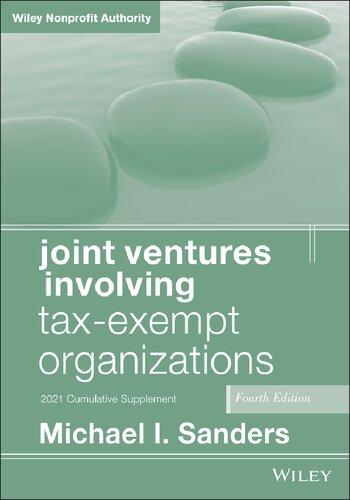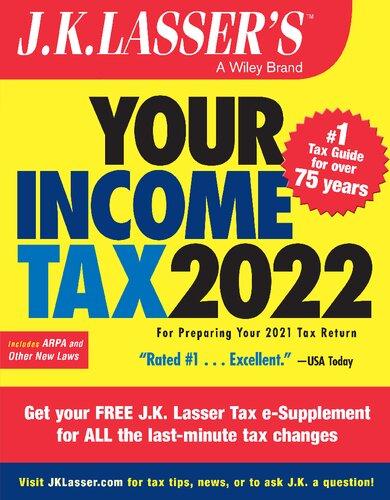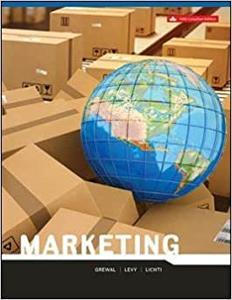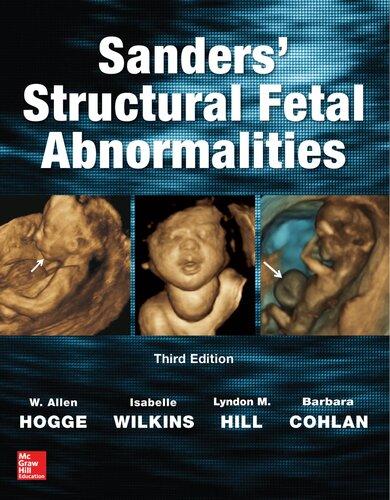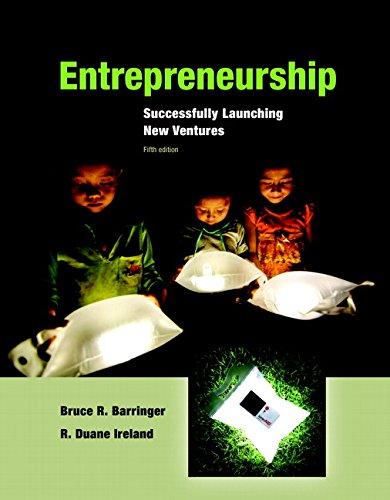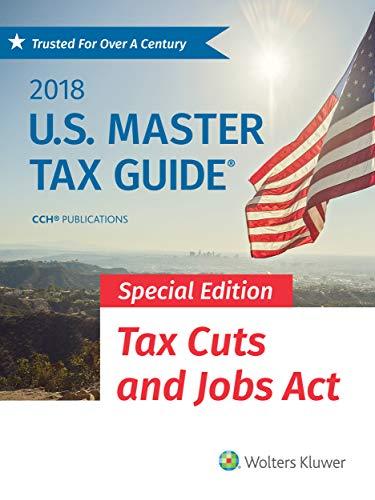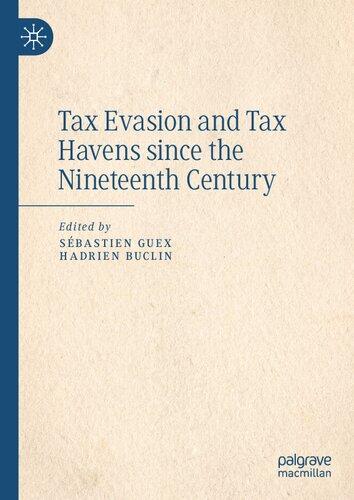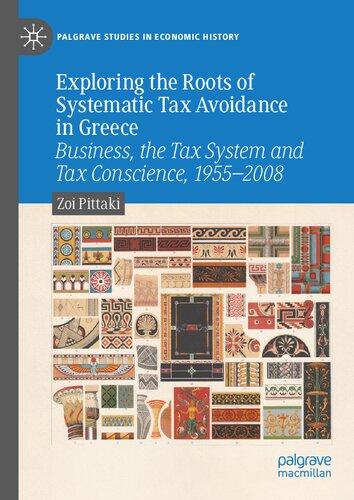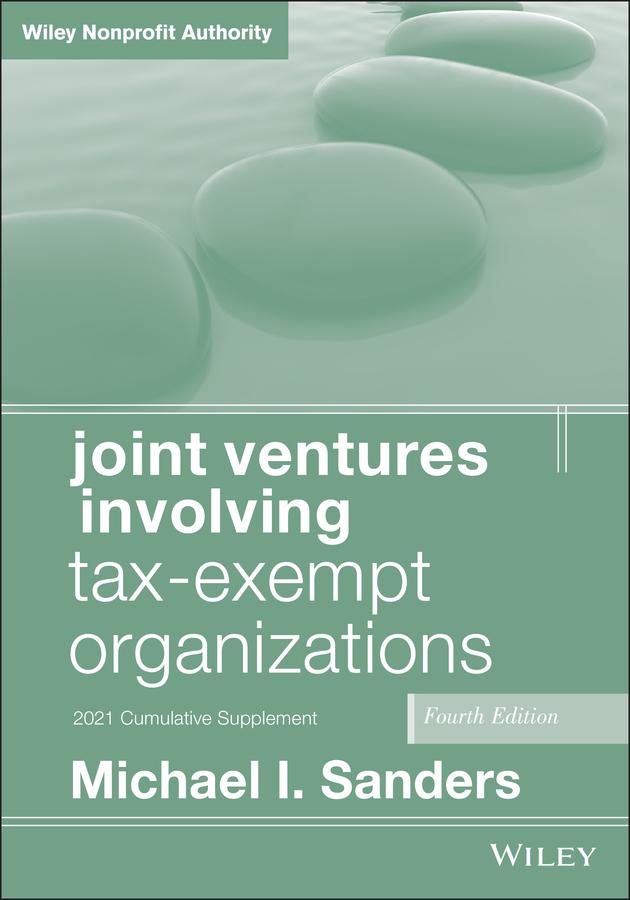Visit to download the full and correct content document: https://ebookmass.com/product/joint-ventures-involving-tax-exempt-organizations-202 1-cumulative-supplement-4th-edition-michael-i-sanders/
More products digital (pdf, epub, mobi) instant download maybe you interests ...
Entrepreneurship: Successfully Launching New Ventures (4th Edition ) 4th Edition
https://ebookmass.com/product/entrepreneurship-successfullylaunching-new-ventures-4th-edition-4th-edition/
J.K. LASSER'S YOUR INCOME TAX 2022 : for preparing your 2021 tax return. J.K. Lasser Institute.
https://ebookmass.com/product/j-k-lassers-your-incometax-2022-for-preparing-your-2021-tax-return-j-k-lasser-institute/
Marketing 5th Edition (2021) Levy Michael
https://ebookmass.com/product/marketing-5th-edition-2021-levymichael/
Sanders' Structural Fetal Abnormalities 3rd Edition
Isabelle Wilkins
https://ebookmass.com/product/sanders-structural-fetalabnormalities-3rd-edition-isabelle-wilkins/
Übungsbuch Buchführung für Dummies 4th Edition Michael Griga
https://ebookmass.com/product/ubungsbuch-buchfuhrung-furdummies-4th-edition-michael-griga/
Entrepreneurship: Successfully Launching New Ventures 5th Edition, (Ebook PDF)
https://ebookmass.com/product/entrepreneurship-successfullylaunching-new-ventures-5th-edition-ebook-pdf/
U.S. Master Tax Guide (2018) Special Edition Tax Cuts and Jobs Act (Ebook PDF)
https://ebookmass.com/product/u-s-master-tax-guide-2018-specialedition-tax-cuts-and-jobs-act-ebook-pdf/
Tax Evasion and Tax Havens since the Nineteenth Century Sébastien Guex
https://ebookmass.com/product/tax-evasion-and-tax-havens-sincethe-nineteenth-century-sebastien-guex/
Exploring the Roots of Systematic Tax Avoidance in Greece: Business, the Tax System and Tax Conscience, 1955–2008 1st Edition Zoi Pittaki
https://ebookmass.com/product/exploring-the-roots-of-systematictax-avoidance-in-greece-business-the-tax-system-and-taxconscience-1955-2008-1st-edition-zoi-pittaki/
jointventures involving tax-exempt organizations Copyright©2022byJohnWiley&Sons,Inc.Allrightsreserved.
PublishedbyJohnWiley&Sons,Inc.,Hoboken,NewJersey.
PublishedsimultaneouslyinCanada.
Nopartofthispublicationmaybereproduced,storedinaretrievalsystem,ortransmittedinanyformorbyany means,electronic,mechanical,photocopying,recording,scanning,orotherwise,exceptaspermittedunderSection 107or108ofthe1976UnitedStatesCopyrightAct,withouteitherthepriorwrittenpermissionofthePublisher,or authorizationthroughpaymentoftheappropriateper-copyfeetotheCopyrightClearanceCenter,Inc.,222 RosewoodDrive,Danvers,MA01923,(978)750-8400,fax(978)646-8600,orontheWebat www.copyright.com RequeststothePublisherforpermissionshouldbeaddressedtothePermissionsDepartment,JohnWiley&Sons, Inc.,111RiverStreet,Hoboken,NJ07030,(201)748-6011,fax(201)748-6008,oronlineat http://www.wiley.com/ go/permissions
LimitofLiability/DisclaimerofWarranty:Whilethepublisherandauthorhaveusedtheirbesteffortsinpreparing thisbook,theymakenorepresentationsorwarrantieswithrespecttotheaccuracyorcompletenessofthecontentsof thisbookandspecificallydisclaimanyimpliedwarrantiesofmerchantabilityorfitnessforaparticularpurpose.No warrantymaybecreatedorextendedbysalesrepresentativesorwrittensalesmaterials.Theadviceandstrategies containedhereinmaynotbesuitableforyoursituation.Youshouldconsultwithaprofessionalwhereappropriate. Neitherthepublishernorauthorshallbeliableforanylossofprofitoranyothercommercialdamages,includingbut notlimitedtospecial,incidental,consequential,orotherdamages.
Forgeneralinformationonourotherproductsandservicesorfortechnicalsupport,pleasecontactourCustomer CareDepartmentwithintheUnitedStatesat(800)762-2974,outsidetheUnitedStatesat(317)572-3993orfax(317) 572-4002.
Wileypublishesinavarietyofprintandelectronicformatsandbyprint-on-demand.Somematerialincludedwith standardprintversionsofthisbookmaynotbeincludedine-booksorinprint-on-demand.Ifthisbookrefersto mediasuchasaCDorDVDthatisnotincludedintheversionyoupurchased,youmaydownloadthismaterialat http://booksupport.wiley.com.FormoreinformationaboutWileyproducts,visit www.wiley.com
LibraryofCongressCataloging-in-PublicationDataisAvailable: ISBN9781118317112(mainedition)
ISBN9781119845607(supplement)
ISBN9781119845621(ePDF)
ISBN9781119845614(ePub)
CoverDesign:Wiley
CoverImage:©iStock.com/FelixMockel
Tomywifeof50+ wonderfulyears, Judy,whoselove,devotion,andpatience havemadethisbookpossible; andtoDavid,Patty,Hayley,andJacob; Noah,Brooke,Emme,andRyderAaron; Adam,Randi,Gabby,andEva; andSammy,Rebecca,Benjamin,andJonah.
Contents Prefacexi Acknowledgmentsxiii
Chapter1:Introduction:JointVenturesInvolvingExemptOrganizations1
§1.4UniversityJointVentures1
§1.5Low-IncomeHousingandNewMarketsTaxCreditJointVentures1
§1.6ConservationJointVentures2
§1.8Rev.Rul.98-15andJointVentureStructure2
§1.10AncillaryJointVentures:Rev.Rul.2004-512
§1.14TheExemptOrganizationasaLenderorGroundLessor2
§1.15PartnershipTaxation3
§1.17UseofaSubsidiaryasaParticipantinaJointVenture3
§1.22LimitationonPrivateFoundation’sActivitiesThatLimitExcess BusinessHoldings3
§1.24OtherDevelopments(Revised)4
Chapter2:TaxationofCharitableOrganizations9
§2.1Introduction9
§2.2CategoriesofExemptOrganizations(Revised)15
§2.3§501(c)(3)Organizations:StatutoryRequirements(Revised)19
§2.4CharitableOrganizations:GeneralRequirements22
§2.6ApplicationforExemption(Revised)23
§2.7Governance31
§2.8Form990:ReportingandDisclosureRequirements(Revised)32
§2.10TheIRSAudit(Revised)34
§2.11CharitableContributions(Revised)38
Chapter3:TaxationofPartnershipsandJointVentures47
§3.1ScopeofChapter47
§3.3ClassificationasaPartnership50
§3.4AlternativestoPartnerships50
§3.7FormationofPartnership50
§3.8TaxBasisinPartnershipInterest50
§3.9PartnershipOperations51
§3.10PartnershipDistributionstoPartners(New)52
§3.11SaleorOtherDispositionofAssetsorInterests52
§3.12OtherTaxIssues53
Chapter4:Overview:JointVenturesInvolvingExemptOrganizations59
§4.1Introduction59
§4.2ExemptOrganizationasGeneralPartner:AHistoricalPerspective60
CONTENTS §4.6RevenueRuling2004-51andAncillaryJointVentures62
§4.9ConversionsfromExempttoFor-ProfitandfromFor-ProfittoExempt Entities62
§4.10AnalysisofaVirtualJointVenture62
Chapter5:PrivateBenefit,PrivateInurement,andExcessBenefit Transactions65
§5.1WhatArePrivateInurementandPrivateBenefit?65
§5.2TransactionsinWhichPrivateBenefitorInurementMayOccur67
§5.3Profit-MakingActivitiesasIndiciaofNonexemptPurpose69
§5.4IntermediateSanctions(Revised)69
§5.7StateActivitywithRespecttoInsiderTransactions78
Chapter6:EngaginginaJointVenture:TheChoices81
§6.1Introduction81
§6.2LLCs82
§6.3UseofaFor-ProfitSubsidiaryasParticipantinaJointVenture (Revised)83
§6.5PrivateFoundationsandProgram-RelatedInvestments94
§6.6NonprofitsandBonds98
§6.7ExploringAlternativeStructures101
§6.8OtherApproaches(Revised)102
Chapter7:ExemptOrganizationsasAccommodatingPartiesinTax ShelterTransactions111
§7.2PreventionofAbusiveTaxShelters111
§7.3ExciseTaxesandPenalties112
Chapter8:TheUnrelatedBusinessIncomeTax113
§8.1Introduction113
§8.3GeneralRule114
§8.4StatutoryExceptionstoUBIT115
§8.5ModificationstoUBIT116
§8.7CalculationofUBIT(Revised)116
Chapter9:Debt-FinancedIncome133
§9.1Introduction133
§9.2Debt-FinancedProperty133
§9.6TheFinalRegulations134
Chapter10:LimitationonExcessBusinessHoldings137
§10.1Introduction137
§10.2ExcessBusinessHoldings:GeneralRules137
§10.3TaxImposed139
§10.4Exclusions(Revised)139
CONTENTS Chapter12:HealthcareEntitiesinJointVentures145
§12.1Overview145
§12.2ClassificationsofJointVentures146
§12.3TaxAnalysis147
§12.4OtherHealthcareIndustryIssues149
§12.5Preservingthe50/50JointVenture150
§12.9GovernmentScrutiny150
§12.11ThePatientProtectionandAffordableCareActof2010:§501(R) andOtherStatutoryChangesImpactingNonprofitHospitals151
§12.12ThePatientProtectionandAffordableCareActof2010:ACOs andCo-Ops:NewJointVentureHealthcareEntities154
Chapter13:Low-IncomeHousing,NewMarkets,Rehabilitation, andOtherTaxCreditPrograms155
§13.2Nonprofit-SponsoredLIHTCProject155
§13.3Low-IncomeHousingTaxCredit(Revised)156
§13.4HistoricInvestmentTaxCredit159
§13.6NewMarketsTaxCredits(Revised)169
§13.10TheEnergyTaxCredits185
§13.11TheOpportunityZoneFunds:NewSection1400Z-1andSection 1400Z-2(Revised)186
Appendix13B242
Chapter14:JointVentureswithUniversities259
§14.1Introduction(Revised)259
§14.3CollegesandUniversitiesIRSComplianceInitiative265
§14.5FacultyParticipationinResearchJointVentures266
§14.6NonresearchJointVentureArrangements269
§14.7ModesofParticipationbyUniversitiesinJointVentures269
Chapter15:BusinessLeaguesEngagedinJointVentures275
§15.1Overview275
§15.2TheFive-ProngTest276
§15.3UnrelatedBusinessIncomeTax276
Chapter16:ConservationOrganizationsinJointVentures277
§16.1Overview277
§16.2ConservationandEnvironmentalProtectionasaCharitable orEducationalPurpose:PublicandPrivateBenefit277
§16.3ConservationGiftsand§170(h)Contributions(Revised)278
§16.7EmergingIssues302
Chapter17:InternationalJointVentures303
§17.5GeneralGrantmakingRules(Revised)303
§17.11ApplicationofForeignTaxTreaties305
Chapter19:DebtRestructuringandAssetProtectionIssues307
§19.1Introduction307
§19.2OverviewofBankruptcy307
§19.3TheEstateandtheAutomaticStay308
§19.4CaseAdministration309
§19.5Chapter11Plan310
§19.6Discharge311
§19.7SpecialIssues:ConsequencesofDebtReduction311 Index313
Preface Astheyearcomestoanend,theboardsofnonprofitorganizationsare takingalookbackat2020–2021toreflectonthechallengestheyfaced, aswellastheiraccomplishmentsandtheirfailures,toguidethemin definingfuturestrategiesandopportunities.Indeed,whiledonationsto charitieswereexpectedtodropbyatleast$13billioneachyearasaresult oftheJCJA’schangestothecharitablecontributiondeduction,ithasbeen reportedthatthepercentageoftaxpayerswhoitemizetheirdeductions declinedby35percent.1 ItisnosurprisethattheCOVID-19pandemic forcedmanyexemptorganizationstodo“morewithless”andtocreate newworkplacestrategiesandbusinesspracticestosustaintheirmissions, inmanycasescreatingwhatmaybepermanentchange.2 Forexample,at theuniversitylevel,thesectorpivotedandrespondedtotheneedsand safetyofstudentswithpainfuldecreasesinrevenueandincreasedcosts.In fact,ItaughtoverthepastyearandahalfatGWLawandGeorgetownLaw Centeronaremotelearningplatform.Charitableorganizationsneeded torespondtotheescalatedneedforsocialserviceswhilemaintaining pre-pandemicgivingcommitmentsandinvestmentreturns.
Charitieswerefacedwiththebalancingoftheirownfinancialneeds, bothsupportingnonprofitsthathadlostfundingandrecognizingthe growingneedsofthecommunity,includingunemploymentandfood insecurity.Forthisreasontheuseofjointventures,impactinvesting,and mission-relatedinvestments,amongothertechniques,havebecomeeven morecriticaltothesustainabilityofthecharitablesector.Commercial co-venturinghasraisedsignificantamountsofmoney.Therearestudies thatshowthatmillennialsprefertomakepurchasesthatidentifywith “causes,”somanysocialmediaplatformsnowprovidethemeansby whichthepubliccanalsosolicitmoneyforcharities.However,thisisa typicallyunregulatedarea,althoughinsomestatesthereisregulation ofvariouskinds.Itisclearthatmanycharitiesareunderfinancialstrain fortheforegoingreasons,butitshouldbekeptinmindthatinthelast go-roundaftertheGreatRecession,charitiesthatwereindirestraitswere abletorestructureand,inmanycases,mergeasawaytopreservetheir charitablegoals.
InChapter2,thereisacontinuedreviewoftheimpactoftheCARES Actoncontributionsbyindividualsandcorporationsthatprovidesignificanttemporarytaxreliefandcharitablegivingbenefits.Thereisalsoa
1 JaneneR.Finley, ReformingtheCharitableContributionTaxDeduction:AccountingforRandomActs ofCharity,10Wm.&MaryBus.L.Rev.479,481(2019).
2 CohnReznick(AlfonsoandMcGowan),AYearinReview(Feb.2021).
discussionofNotice2020-36regardingmodificationsofthegroupexemptionrules,followedbyanexplanationofthecompliancestrategyand commercialitydoctrine,whichhasbeenexpandedinrecenttimes.
InChapter3,thereisabriefdiscussionofwaterfallandclawbackrules withregardtopartnershipdistributionstopartners.
InChapter5,thereisadiscussionofthefinalregulationsunderSection 4960,includingchangestotheproposedregulationsregardingvolunteers andcoveredemployees.
InChapter6,thereisanexpandeddiscussionofimpactinvestingand thecommercialismdoctrine.Thereisalsoanewdiscussionregardingcommercialco-ventures,whichhavebecomequitepopular.Andfinallythere isanexpandeddiscussionoftheuseofCcorporationsandREITblockers, includinganumberofdiagramsillustratingtheireffect.
InChapter8,thereisadiscussionofthefinalsiloregulationsand changesmadefromtheproposedregulations.
InChapter10,thereisadiscussionregardingthecontributionofnonvotingLLCinteresttoaprivatefoundation,withananalysisoftheimpact oftheself-dealingandexcessbusinessholdingimplications.
InChapter13,thereisanupdateofLIHTC,alongwiththevariousIRS noticesrelativetoopportunityzonefundsinwhichtheproposedruleshave beenrevised;inthisregard,thediscussionofthewrittenplanexception toQOZBsandforeigninvestmentsthatfollowthepublicationofthefinal regulations.Thereisalsoasubsectiondiscussingproposedlegislativerecommendationstoimproveguardrailsandincentiveswithoutresultingin unduedisruptiontocommunitiesormarketparticipants.Finallythereisa discussionofnewmarkettaxcredits,whichhavebeenextendedthrough 2025withanadditional$5millionannually.Thenewmarkettaxcreditarea hasalsoreceivedalotofattentionrelativetounwinds,whichoccurafter seven-yearcompliance.
InChapter14thereisadiscussionofthefinalregulationsunder Section4968,whichgenerallyfollowtheproposedregulations.
Thebottomline,onceagain,isthatthereisnooneparadigmforjoint ventures,especiallyinthefaceoftheCOVID-19pandemicanditscontinuedpressuresonthebudgetandreducedfundraising.Aspreviously discussed,inviewofthefinancialdistressthatexemptorganizationshave faced,theynowneedtobeevenmorecreativeandforgenewpathstocreateandsolvemanyissuesaffectingtheirfutureandoperations.Thistext isintendedtosuggestmechanismstoaccomplishtheworthygoalsofthe charitablecommunities,especiallyfollowingthepandemiccrisis.Wealso believethattheopportunityzonelegislationwillsurviveundertheBiden administrationand,infact,islikelytobeexpanded;however,withadditionalreportinganddisclosurerequirements.Itshouldcreateanextremely attractablealternativetoallowfundstoberedirectedtoincludetherevised 2020censustract.
Acknowledgments IwanttocallattentiontotheworkofanumberofthegraduatetaxstudentsatGeorgetownLawCenterwhohavetakentheclassSpecialTopicsin ExemptOrganizationsandhavewrittenpapersthathaveservedtoprovide substantivematerials,whichareincludedinthetext:PhilipHarris,who haswrittenonthe“commercialitydoctrine”;ConorKratz,whohaswrittenapaperregardingnewmarkettaxcredits;andDavidKolokolo,whohas writtenonforeigngrantmakingrules.IagainthankAmandaH.Nussbaum, whopresentedatGeorgetownUniversityLawCenteronUBITandPEpracticeandprovidedexamplesastotheuseofblockers;andCynthiaPaine, forupdatingtheLIHTCmaterial.Finally,asalways,IappreciatetheoutstandingcontributionofRonaldSchultzatAlliantGroupforhislecturesat GeorgetownUniversityLawCenterandhisdraftofcurrentdevelopments regardingconservationorganizations.
IespeciallyacknowledgeLindaSchrader,whoseextraordinarykindnessandsensitivityhavebeeninvaluableinthepreparationofthe manuscriptaswellashercoordinationwiththestaffatJohnWiley&Sons; Lindahasbeencriticaltotheentireprocesssincethebeginningofthe treatise.
CHAPTER1 Introduction:JointVentures InvolvingExemptOrganizations §1.4UniversityJointVentures1
§1.5Low-IncomeHousingandNew MarketsTaxCreditJoint Ventures1
§1.6ConservationJointVentures2
§1.8Rev.Rul.98-15andJointVenture Structure2
§1.10AncillaryJointVentures:Rev.Rul. 2004-512
§1.14TheExemptOrganizationasa LenderorGroundLessor2
§1.15PartnershipTaxation3
§1.17UseofaSubsidiaryasa ParticipantinaJointVenture3
§1.22LimitationonPrivate Foundation’sActivitiesThatLimit ExcessBusinessHoldings3
§1.24OtherDevelopments(Revised)4
§1.4UNIVERSITYJOINTVENTURES p.11. Addthefollowingnewparagraphattheendofthissection: Thereiscontinuedcongressionalfocusonuniversityendowmentsin lightofthesoaringcostoftuitionandtheperceivedrelativelylowrate offinancialassistanceprovidedbycollegesanduniversitieswithsubstantialendowments.SeeChapter14foradiscussiononpolicychangesthat arebeingproposed,includingimposinganannualpayoutrequirementon endowmentfunds,amongothers.
§1.5LOW-INCOMEHOUSINGANDNEWMARKETSTAX
CREDITJOINTVENTURES pp.13–14. Deletethelastparagraphonp.13andreplacewiththefollowing:
TheCDFIFundhasmade1,254allocationawardstotaling$61billion inallocationauthoritysincetheNMTCProgram’sinception.SinceinceptionthroughFY2019,CDEshavedisbursedatotalof$52.5billioninQEI proceedstolow-incomecommunitybusinesses(QALICBs).
§1.6CONSERVATIONJOINTVENTURES p.15. Addthefollowingtothelastparagraphofthissection:
InJanuary2014,TreasuryandtheIRSissuedRevenueProcedure 2014-12,2014-3I.R.B.414,whichestablishedasafeharborforfederal historictaxcreditinvestmentsmadewithinasingletierthroughamaster leasepass-throughstructure.Theguidancewasissuedinresponsetothe HistoricBoardwalk decisionreferencedearlier.
§1.8REV.RUL.98-15ANDJOINTVENTURESTRUCTURE p.18. Addthefollowingtotheendoffootnote65:
PLR201744019(revocationofexemptionofa§501(c)(3)exempthospitalthatwasnotoperated exclusivelyfor§501(c)(3)purposesbecauseitlackedtheabilitytorequireafor-profitmanagertooperateforcharitablepurposes).
§1.10ANCILLARYJOINTVENTURES:REV.RUL.2004-51 p.21. Addthefollowingnewparagraphtotheendofthissection:
InSection4.10,thereisananalysisofavirtualjointventurehypothetical,astowhichasimilarrationaleshouldapplyinacaseinwhichthe IRSproposestherevocationofanexisting501(c)(3)organization,alleging impermissibleprivatebenefitfollowinganexaminationofitsrelationship withafor-profitentity.Thiscommentatorbelievesthattherationaleshould apply,notwithstandingthefactthatnoformaljointventurearrangement existsbetweentheparties.
§1.14THEEXEMPTORGANIZATIONASALENDER ORGROUNDLESSOR p.28. Insertthefollowingattheendofthissection:
TheInternalRevenueServicerecentlyissuedfinalguidanceforprivate foundationsthatupdatesexamplesthatrelatetoprogram-relatedinvestmentsthatpassmusterunder§4944(c).Therules(T.D.9762)provide changesandexamplesthatwerefirstprovidedinthe2012Proposed Regulations.Seesubsection6.5(b)foradetaileddiscussionofthenew examples.
InApril2016theIRSissuedfinalguidanceforprivatefoundations thatupdatesanumberofexamplesofprogram-relatedinvestmentsthat won’ttriggerexcisetaxes.FinalRules(T.D.9762)illustratechangestothe examplesprovidedinthe2012ProposedRules.InonechangeinvolvingExample11,aprivatefoundationthatinvestedinadrugcompany subsidiarydevelopingavaccinefordiseasepredominantlyaffectingpoor
§1.22LIMITATIONONPRIVATEFOUNDATION’SACTIVITIES
peopleindevelopingcountriesrecognizesthat,inadditiontodistributing thevaccineataffordableprices,thesubsidiaryisallowedtosellthevaccine tothosewhocanafforditatfairmarketvalueprices.InChapter6,eachof theexamplesanditsrevisedTreasuryguidelinesaresetforth.
§1.15PARTNERSHIPTAXATION (a)Overview
p.30. Addthefollowingnewparagraphtotheendofthissubsection:
IntheBipartisanBudgetActof2015,thepartnershipauditruleshave beenrevised,theeffectofwhichisthatadjustmentsofincome,gain,loss, deduction,orcreditaretobedeterminedatthepartnershiplevelandthe taxesattributabletheretowillbeassessedandcollectedatthepartnership level.ThenewrulesareeffectivebeginningtaxableyearsafterDecember 31,2018,althoughsmallpartnershipsmayoptoutbeforethen.SeeChapter 3foradiscussionoftheapplicationofthenewrules.
(b)BargainSaleIncluding“LikeKind”Exchange p.30. Addthefollowingtotheendoffootnote101: SeediscussionsregardingcontributionofLLC/partnershipintereststocharityinsubsection 2.11(f), infra,andSection3.11,SaleorOtherDispositionofAssetsorInterests.
§1.17USEOFASUBSIDIARYASAPARTICIPANT INAJOINTVENTURE p.34. Addthefollowingparagraphafterthefirstfullparagraphonthis page:
InSeptember2015,NationalGeographicSocietyformedajointventure with21stCenturyFox,calledtheNationalGeographicPartners,afor-profit mediajointventure.Inthisnewventure,Foxcontributedasubstantial amountofcashtoNationalGeographic,whichincreaseditsendowment tonearly$1billion,inexchangeforthecontributionofsignificantassets, includingitstelevisionchannelsandrelateddigitalandsocialmedia platforms.Seesubsection6.3(b)(iv)forananalysisofthestructure.
§1.22LIMITATIONONPRIVATEFOUNDATION’S ACTIVITIESTHATLIMITEXCESSBUSINESS HOLDINGS p.45. Addthefollowingfootnotetotheendofthissection: 163.1 SeediscussionregardingthecontributionofLLC/partnershipintereststocharityinsubsection2.11(f).
§1.24OTHERDEVELOPMENTS(REVISED) p.47. Addthefollowingasfootnote175tothelastsentenceofthissection: 175 In Burwellv.HobbyLobbyStores,Inc.,theSupremeCourtcitedp.555inthisbook,which described Google.org advancingitscharitablegoalswhileoperatingasafor-profitcorporation.See footnote24ofthe HobbyLobby decision,134S.Ct.2751(2014).Thecourtrecognizedthatwhileoperating asafor-profitcorporation,itisabletoinvestinfor-profitendeavors,dolobbying,andtapGoogle’s innovativetechnologyandworkforce.Itacknowledgedthatstateshaveincreasinglyadoptedlaws formallyrecognizinghybridcorporateforms.
p.47.Addthefollowingattheendofthesubsection:
WiththegrowingimpactofCOVID-19,manybusinessownersareinterestedinprovidingfinancialassistancetotheirfurloughedorterminated employees,eventhoughtheycannotaffordtokeepthemontheirpayroll. Anattractiveoptionisthecreationofanemployer-sponsoredcharityto raisetax-deductiblecontributionstobedistributedtoformeremployees whodemonstrateneed.Inaddition,asupplementalunemploymentbenefittrustundersection501(c)(17)canbeformedaspartofaplantopay supplementalunemploymentcompensationbenefits.Undersection139, employerscanprovideassistancedirectlytoanemployeefreeofincome tax,providedthefundsareusedtopayorreimburseamountsthatarereasonablyexpectedtobeincurredforincrementalpersonal,family,orliving expensesasaresultoftheCOVID-19crisis.
Undersection139,paymentsmaycoverthefollowingexpenses: (1)unreimbursedmedicalexpensesandhealth-relatedexpenses;(2)home expensesduetotelecommuting;(3)housingcostsforadditionalfamily members;(4)increasedchildcareandtutoringcostsduetoschoolclosings; (5)additionalcommutingexpenses;and(6)increasedcostsofhomeoffice supplies.
Anemployer-sponsoredcharitymaycovernotonlythoseemployees whoaresufferingundertheimpactofCOVID-19butmaycoverfuture hardshipsaswell.However,charitiesbenefitingindividualsarepermissibleiftheclassofeligiblebeneficiariesisbroadenoughtobeconsidered “indeterminable.”Forexample,acharitydesignedtobenefitpast,current, andfutureemployeesofanentirerestaurantgroupduetothepandemicand futuredisastersisbroadenoughandthebeneficiariesarenotimmediately identifiablebecauseunknownfutureemployeesandcurrentemployees whoarevictimsoffuturedisastersareeligiblebeneficiaries.Secondly,the individualswhoareinvestedwiththeauthoritytomakethegrants—the boardofdirectorsoracommitteeappointedbytheboard—mustconsist ofamajorityofindividualswhodonotexert“substantialinfluence”over thebusinesswithrank-and-fileemployeesandshouldbeincludedamong thedecisionmakers.Finally,individualswhodemonstrateafinancialneed areeligibletoreceiveassistance,butthecharityshouldavoidgivinga“one sizefitsall”granttoeveryemployee.Acceptablepurposesforsuchgrants
§1.24OTHERDEVELOPMENTS(REVISED)
includepaymentofnecessaryhealthcareexpenses;providingcostofchildcareoreducationalexpensesforchildrenofemployees;orshort-termgrants meanttocoverbasiclivingexpenses.
Thecharityshouldretaindocumentationregardingtheemployee’seligibilityforagrant andverificationthattheemployeeusedthefundsforeligiblepurposes.176
Businessesthatcontemplateseverancepaymentstoworkersshouldconsiderstructuring suchpaymentssothattheyqualifyundersection139.Ifso,thepaymentswouldappear tobeexemptfromincometaxandmostpayrolltaxes.However,anypaymentspursuant toalegalorcontractualobligationtopayseverancewouldbedifficulttocategorizeas section139payments.Secondly,section139contemplatespaymentscommensuratewith expensestheyintendtooffset,whileseverancepaymentsareoftencomputedbasedupon yearsofserviceandsalarylevels.
InNotice2020-46,theIRSprovidedguidancetoemployersforhow toexchangeemployeeelectionstoforgovacation,sick,orpersonalleave forcashpaymentsthattheemployermakestocharitableorganizationsfor COVID-19relief.Anemployeewhoelectstorelinquishaidleavewillnot betaxedonthevalueoftheleave,ifthepaymentsinexchangeforthe leavearemadebytheindividual’semployerpriortoJanuary,1,2021,to a§170(c)organizationthatprovides“relieftovictimsoftheCOVID-19 pandemic.”
AlthoughnotexplicitintheIRSnotice,theuseofthephrase“victimsoftheCOVID-19 pandemic”canbereadtomeanthatthepermissibleuseofthedonationsextendsnotonly toassistpeoplewhocontractthedisease,butalsotopeoplewholosetheirjobsorare otherwisefinanciallyharmedbythepandemic.177
176 Itisimportanttonotethatasanalternative,employersmaybeabletoassisttheiremployees bymakingqualifieddisasterreliefpaymentsonatax-freebasisundersection139oftheCode, previouslydiscussed.
177 EmployerswillhavethechoiceofdeductingthesecontributionseitherundertherulesofCode §170,asacharitablecontributiondeduction,orundersection162,whichrelatestothededuction forordinaryandnecessarybusinessexpenses.ThebenefitoftakingadeductionunderCode§162 asopposedtoCode§170isthattheemployerwillnotbesubjecttocertainlimitationsthatsection 170imposesontheamountofthepaymentthatisdeductibleintheyearofthepayment.
CAVEAT
CAVEAT
CAVEAT
TheCARESActexpandedthedefinitionofeducationalassistancefor purposesofsection127oftheInternalRevenueCodeof1986,asamended, toincludecertainemployerpaymentsmadeafterMarch27,2020under an“educationalassistanceprogram”178 forrepaymentofemployeestudent loans.Asaresult,throughtheendofthe2025taxableyear,anemployer canmaketax-freepaymentstoitsemployeesforstudentloanassistance ofupto$5,250peryear.Paymentsinexcessof$5,250peryear(andpaymentsthatarenotmadepursuanttoaneducationalassistanceprogram (asdescribedbelow))wouldbeincludedintheemployee’sgrossincome. Additionalrulesandrequirementsrelatedtoqualifiedpaymentsandeducationalassistanceprogramsaredescribedbelow.
•Thepaymentscanbemadetotheemployeeordirectlytothelender, forrepaymentofeitherprincipalorinterest,solongasthepayments aremadewithrespecttoa“qualifiededucationloan”andcertain requirementsundersection127oftheCodearemet.Aqualifiededucationloanwouldgenerallyincludeanystudentloanthatispartof afederalpostsecondaryeducationloanprogramthatisincurredfor “qualifiededucationexpenses”oftheemployee’seducation,such astuitionandfees,roomandboard,books,certainsuppliesand equipment,andcertainothernecessaryexpensesfortheemployee’s education.Thequalifiededucationexpensesmustgenerallybepaid orincurredwithstudentloanproceedswithinareasonableperiod oftimebeforeoraftertheemployeetakesouttheloan.
•Inorderforthepaymentstoemployeestoqualifyforthegross incomeexclusion,thepaymentsmustbemadepursuanttoa separatewritteneducationalassistanceprogramestablishedforthe exclusivebenefitoftheemployer’semployeessoastoprovidethem witheducationalassistance.
•Theemployercanestablishcertainrestrictions(subjecttothe nondiscriminationrulesundersection127oftheCode,discussed below)onanemployee’seligibilityundertheprogramsuchas jobrelationshiprequirements,limitationonwhenandwherethe coursescanbetaken,preapprovalbytheprogrammanagerorthe
178 Theterm“educationalassistance”means(a)thepayment,byanemployer,ofexpensesincurredby oronbehalfofanemployeeforeducationofthatemployee(including,butnotlimitedto,tuition,fees, andsimilarpayments,books,supplies,andequipment);(b)inthecaseofpaymentsmadebeforeJanuary1,2021,thepaymentbyanemployer,whetherpaidtotheemployeeortoalender,ofprincipalor interestonanyqualifiededucationloan(asdefinedin§221(d)(1))incurredbytheemployeeforeducationoftheemployee;and(c)theprovision,byanemployer,ofcoursesofinstructionforsuchemployee (includingbooks,supplies,andequipment),butdoesnotincludepaymentfor,ortheprovisionof, toolsorsuppliesthatmayberetainedbytheemployeeaftercompletionofacourseofinstruction,or meals,lodging,ortransportation.Theterm“educationalassistance”alsodoesnotincludeanypayment for,ortheprovisionof,anybenefitswithrespecttoanycourseorothereducationinvolvingsports, games,orhobbies.(See§127(c)(1).)
§1.24OTHERDEVELOPMENTS(REVISED)
employee’ssupervisor,proofofcompletionofthecourse,minimum coursegrades,andcompletionofacertainperiodofemployment aftercompletionofthecourse.
•Thefollowingareadditionalrequirementsoftheeducationalassistanceprogramundersection127oftheCode:
∘ Theprogrambenefitsemployeeswhoqualifyunderrulessetup bytheemployer(suchasthosedescribedaboveintheimmediatelyprecedingbulletpoint)thatdonotdiscriminateinfavorof highlycompensatedemployees(i.e.,anemployeewho(i)during thecurrentorprecedingtaxyearisorwasamorethan5percent ownerwithrespecttotheemployer,or(ii)earnedcompensation inexcessof$130,000(forthe2021taxyear)unlesssuchemployee wasnotalsointhetop20percentofemployeesbypayfortheprecedingyearandtheemployerchoosesnottotreatsuchindividual asahighlycompensatedemployee);
∘ Theprogramdoesnotprovideformorethan5percentofitstotal benefitsduringtheyeartoitsmorethan5percentshareholdersor owners(ortheirspousesordependents);
∘ Theprogramdoesnotallowtheemployeestoreceivecashorother benefitsthatmustbeincludedingrossincomeinsteadofeducationalassistance;and
∘ Theemployermustgivereasonablenoticeoftheprogramtoits eligibleemployees.
•Anemployercanchoosetotreatthefollowingindividualsasemployeesforpurposesoftheincomeexclusionrules:acurrentemployee; aformeremployeewhoretired,leftondisability,orwaslaidoff;a leasedemployeewhoprovidedservicesundertheemployer’sprimarydirectionorcontrolonasubstantiallyfull-timebasisforatleast ayear;andself-employedindividuals(suchasanownerofabusiness iftheemployerisasoleproprietorship,orapartnerwhoperforms servicesforapartnershipiftheemployerisapartnership).
•Theprogramdoesnotneedtobefundedtoqualify.
•Theemployermay,butisnotrequiredto,obtainadetermination letterfromtheIRSthattheprogramisaqualifiededucationalassistanceprogram.
CHAPTER2 TaxationofCharitable Organizations §2.1Introduction9
§2.2CategoriesofExempt Organizations(Revised)15
§2.3§501(c)(3)Organizations:Statutory Requirements(Revised)19
§2.4CharitableOrganizations:General Requirements22
§2.6ApplicationforExemption (Revised)23
§2.1INTRODUCTION §2.7Governance31
§2.8Form990:ReportingandDisclosure Requirements(Revised)32
§2.10TheIRSAudit(Revised)34
§2.11CharitableContributions (Revised)38
p.50. Insertquotationmarksaround IRC online8andaddacommaafter contributionsandchurches infootnote2.
p.52. Insertthefollowingafterthelastparagraphofthissection: Inthe2017TaxAct(Pub.L.No.115-97)(the“TaxAct”),thefollowing changesaffecttax-exemptorganizations:
1.New2017Legislation A. Charitablecontributionsarelikelytodeclineasaresultofthe loweringoftheindividualincometaxbrackets(amaximum rateof37percent)whiledoublingthestandarddeduction. TheseratesandthestandarddeductionsunsetafterDecember 31,2025.Itisprojectedthatonly5percentoftaxpayerswill havesufficientitemizeddeductionsthatexceedthestandard deductionthatwillenablethemtocontinuetoclaimacharitablecontributiondeduction,whichmaycurtailcharitable giving.Moreover,theestatetaxexemptionwasdoubledsothat individualsnowhave$11millionofexemptionandmarried couplesareabletoexclude$22.4millionfromtheirestatetax.
ThisprovisionalsosunsetsafterDecember31,2025.Finally, thereisareductionintheCCorporationratesto21percent, whichisapermanentchange.ItisimportanttonotethatC Corpshavebeenthelargestinvestorinjointventures,including thelow-incomehousetaxcreditandnewmarkettaxcredits.
(SeeChapter13.)
B. TheAGIannuallimitationhasbeenincreasedto60percentfor cashcontributions;theprovisionalsosunsetsafterDecember 31,2025.Thereisobviousconcernthatmajordonorsarelikely tobetheonlytaxpayersinapositiontogiveawayupto60 percentoftheirAGIinagivenyear.Inaddition,therulethat requirescontemporarywrittenacknowledgment(§170(f)(8)(D)) nolongerappliesifthedoneeorganizationfilesareturnthat includessimilarcontent.Seesubsection2.11(f).Thecharitable sectorbenefitsbecausetheyhavebeenpressuredbydonorsto fillformsoutinlieuofprovidingastandardacknowledgment. Theproposedregulationsrequiredthereportingofthedonors’ taxIDnumbers/FNS,andcharitieswereconcernedthatitcould leadtotheft.
C. Code§4960proposesanew21percentexcisetaxontax-exempt organizations(modeledon§162(m))for(i)any“remuneration” paidtoacoveredemployeethatexceeds$1million(whetheror notsuchamountsarereasonable)and(ii)on“excessparachute payments”paidtoacoveredpersonunderaseparationagreement(i.e.,severancepaymentsthatexceed3timestheperson’s annualcompensationaveragedoverthepastfiveyears).In thisregard“coveredemployees”includethetopfivemost highlycompensatedemployees(orformeremployees)from thetaxyearoranyonewhowasacoveredemployeefromany precedingtaxableyearbeginningin2017.“Remuneration” isdefinedas“allwages”under§3401(a),excludingRoth contributions,paidbyatax-exemptorganizationorrelated partywithrespecttoemploymentofthecoveredperson.See subsection5.4(b).5.1
TheintermediatesanctionsandexcessbenefitrulesofCode§4958stillapply.
5.1 ForamoredetaileddiscussionofthescopeofCode§4960andthe2019InterimGuidance,see Section5.4.
CAVEAT
CAVEAT TheActextendsthesenewexecutivecompensationlimitationstotax-exemptsnotlimitedto 501(c)(3)sor501(c)(4)s,butincludingbusinesses,federalandstateandlocalentitiesunder §115(1),andpoliticalorganizations.Unliketheintermediatesanctionsexcisetax,§4960 taxappliestotheorganizationitself,notacoveredemployeeororganizationalmanager. Theexcesstaxappliestodeferredcompensationremuneration,whichisviewedas paidwhereitisnolongersubjecttoasubstantialriskofforfeitureunder§457(f)(3)(B). Thus,amountsthatare“vested”butnotyetreceivedbyacoveredemployeewillbesubject totax.5.2
D. Thereisanew,unrelatedbusinessincometax(UBIT)ontransportation,parking,andgymfringebenefitsunlesstheamounts aredeductibleunderCode§274becausetheyaretreatedas partoftheemployee’staxablecompensation.Notethatthishas beenrepealedundertheTaxpayersCertaintyandDisclosure Actof2019.
E. Theunrelatedbusinessincometaxrateisnow21percent, whichwillproviderelieftomanyexemptorganizationsthat havebeenpayingasmuchas35percentonunrelatedtaxable income.However,thisratereductionmaybeoffsetbythenew rulethatnetoperatinglossesfromoneactivitymaynolonger offsetincomefromanotheractivity.Tax-exemptorganizations willneedtocalculatetaxoneachunrelatedbusinessseparately.
QUERY Mayall“investment”activitiesbetreatedasoneactivityforoffsettingpurposes?Willeachof thegainsandlosseshavetobeseparatelystated?Treasurywillneedtopublishregulations toresolvethisissue.
F. Thereisnowanew1.4percenttaxonnetinvestmentincome ofcertaincollegesanduniversitiesdefinedas“applicable educationalinstitutions”(i)thathaveatleast500tuition-paying students,(ii)thathavemorethan50percentoftuition-paying studentslocatedintheUnitedStates,and(iii)whoseassets aggregatedatfairmarketvalueareatleast$500,000perstudent attheendoftheprecedingtaxableyear.SeeSection14.1.Related
5.2 Thereisaspecialcarve-outtopaymentsmadetolicensedmedicalprofessionals,suchasphysicians andveterinarians,sothatthecompensationrelatedtoperformancetomedicalserviceswillnotcount towardthe$1millionthreshold.Accordingly,healthcareorganizationswillneedtotracktimeallocated betweenmedicalservicesandadministrativeservices.
organizationstocollegesanduniversitiesarerequiredtohave theirassetsandnetincomeconsideredwhendetermining whethertheinstitutionmeetstheasset-per-studentthreshold andforpurposesfordeterminingnetinvestmentincome.
Thisnewlegislationistargetedathighlycompensatedcollegeanduniversityathletic coachesandpresidents,someofwhomhavemillion-dollarsalaries.
ThenewBipartisanBudgetActof2018clarifiestheTaxActtoprovidethatthe“atleast 500”and“morethan50percent”ofstudentstestsbothreferonlyto tuition-payingstudents.
Thisnewexcisetaxisestimatedtoraiseapproximately$1.8billioninrevenueoverten yearsandaffectonlyabout35institutions.
G. Arelatedorganizationwillincludeoneinwhichtheeducationalinstitution(a)controlsoriscontrolledby(b)oneor morepersonswhocontroltheinstitutionor(c)aresupported organizationsorsupportingorganizationswithrespectto theinstitution.TheforegoingruleswillrequireTreasury Regulationstoclarifythescopeofthenewprovision.
H. Section170(l)isamendedtoeliminatethespecialruleandnow deniesdeductionsforcollegeboosterseatsincludingseason tickets.
2.ProvisionsThatDidNotSurvivetheTaxAct ItisimportanttoexamineanumberofprovisionsthatwereconsideredbytheHouseandSenatebutthatdidnotsurvivetheConferenceCommittee.Thefollowingprovisionsmaywellbereconsidered thenexttimeextensivetaxlegislationisconsideredbyCongress. Bewareofthepotentialthatsome,ifnotall,oftheseprovisionswill beinplayinthenearfuture.
A. Intheapplicationoftheinitialtaxonadisqualifiedperson pursuanttotheintermediatesanctionsrules,therebuttable presumptionofreasonablenesswouldhavebeeneliminated. (Seesubsection5.4(c)(ii).)Procedureswouldbepromulgated
CAVEAT
CAVEAT
CAVEAT
bytheIRStoestablishthatanorganizationhasperformed minimumstandardsofduediligence(essentiallythesameas thosethatpertaininconnectionwiththepreviouslydescribed presumption)withrespecttoatransactionorotherarrangement involvingadisqualifiedperson(proposedIRC§4958(d)(3)). Theexistingrulebywhichanorganizationmanager’sparticipationinatransactionordinarilyisnot“knowing”participation forpurposesoftheintermediatesanctionsrulesifthemanager reliedonprofessionaladvicewouldbeeliminated(proposed IRC§4958(g)).Thedefinitionofadisqualifiedperson,forpurposesoftheintermediatesanctionsrules,wouldbeexpanded toincludeinvestmentadvisorsandathleticcoachesatprivate educationalinstitutions(seeproposedIRC§4958(f)(1)(G), proposedrevisionofIRC§4958(f)(8)(B)).5.3
B. Theprivatefoundation’sexcisetaxwouldbereducedtoa singlerateof1.4percent(revisedIRC§4940(a),proposedrepeal ofIRC§4940(e)).Alsoarulewouldbeenactedstatingthat anentitycannotbeaprivateoperatingfoundationasanart museumunlessthemuseumisopenduringnormalbusiness hourstothepublicforatleast1,000hoursannually(proposed IRC§4942(j(6)).
C. Asaleorlicensingbyanexemptorganizationoftheentity’s nameorlogo(includinganyrelatedtrademarkorcopyright) wouldbetreatedasanunrelatedbusinessregularlycarriedon (proposedIRC§§512(b)(20),513(k)).Incomederivedfromsuch licensingwouldbeincludedintheorganization’sgrossunrelatedbusinessincome,notwithstandingtheexclusionforcertain typesofpassiveincome(includingotherformsofroyalties).See subsection8.5(d).Theunrelatedbusinessincometaxwouldnot applytoresearchlimitedtopubliclyavailableresearch(seeIRC §512(b)(9)).TheapplicationofUBITtostateandlocalretirement plans(proposedIRC§511(d))wouldbeclarified.
D. Charitableorganizationswouldbeallowedtomakestatements relatingtopoliticalcampaignsintheordinarycourseofprogramactivities,wheretheexpensesaredeminimis(proposed IRC§501(s)),averycontroversialproposalopposedbyboththe IndependentSectorandtheCouncilonFoundations.
E. Thetaxexemptionforprofessionalsportsleagues(IRC§501(c) (6))wouldberepealed.
5.3 Theintermediatesanctionsruleswouldbecomeapplicabletolabororganizations(IRC§501(c)(5) entities)andbusinessleagues(IRC§501(c)(6)entities)(proposedrevisionofIRC§4958(e)(1)).
F. Thestandardmileageratefortheuseofanautomobileforcharitablepurposeswouldbeadjustedtotakeintoaccountthevariablecostsofoperatingthevehicleratherthantheexistinglaw’s 14-cents-per-milededuction.
G. Additionalreportingrequirementsforsponsoringorganizationsofdonor-advisedfundswouldbeenacted,consistingof theaverageamountofgrantsexpressedasapercentageofasset valueandastatementastowhethertheorganizationhasa policyastothefrequencyandminimumlevelofdistributions (proposedIRC§6033(k)(4)).
Attheendofitsspringterm,theSupremeCourtissued adecisionthatsomehavespeculatedcouldleadtogovernmentaloutsourcingofmoreactivitiestononprofits.Thecase, ManhattanCommunityAccessCorp.v.Hallecketal.,587U.S.___ (2019),involvedthequestionofwhetheranonprofitwasa “stateactor”whenNewYorkCitydelegatedtheoperationof publicaccesschannelstoit.Acableoperatortypicallyoperates publicaccesschannelsitselfunlessthelocalgovernmentelects tooperatethemorselectsaprivateentitytodoso.Iffound tobeastateactor,theorganizationwouldbesubjecttothe FirstAmendment.Inthiscase,NewYorkCitydesignateda nonprofittooperatethepublicaccesschannelsofaNewYork cablesystem.Thenonprofit,MNN,airedafilmthatwascritical ofit,butlaterbarredthefilm’sproducersfromfutureaccess tothechannels.Theproducersbroughtsuitongroundsthat thisactionviolatedtheirFirstAmendmentfree-speechrights. Thefive–foursplitfocusedonwhetheroperatingpublicaccess channelsisatraditional,exclusivepublicfunction,withthe majorityrulingthatveryfewfunctionsareexclusivepublic functions.Consistentwiththisruling,ifthegovernmentdelegatesanactivitytoaprivateorganization,suchasanonprofit, anddoesnotdirectitsoperationsoractinpartnershipwithit, thenonprofit’sspeech-relatedactivitieswillnotbesubjectto FirstAmendmentlimits.
3.CARESAct ThenewlyenactedCoronavirusAid,Relief,andEconomicSecurityAct(commonlyknownas“CARESAct”)includesanumberof provisionsdesignedtoencouragecharitablecontributionsofcashto bothindividualsandcorporations.Individualdonorsmakinggifts toqualifiedcharitiesmaydeductupto100percentoftheir2020 adjustedgrossincomeoverandabovetheusualcapof60percent (or50percentifcharitablecontributionsaremadethrougha
